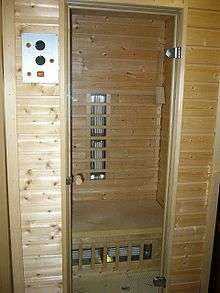Infrared sauna

An infrared sauna uses infrared heaters to emit infrared light experienced as radiant heat which is absorbed by the surface of the skin.[1] Traditional saunas heat the body primarily by conduction and convection from the heated air and by radiation of the heated surfaces in the sauna room. Although saunas have been advertised to provide a wide range of health benefits, such as detoxification, there are no scientific evidence backing these claims.
Health benefit claims
Arthritis
A study of patients with rheumatoid arthritis and ankylosing spondylitis showed a reduction in pain, stiffness and fatigue during infrared sauna therapy, but since results from the study did not reach statistical significance[2] there is no clear or certain relationship between reducing symptoms and using infrared sauna therapy.
Pain relief
According to some users and scientific studies,[3] regular usage of the IR Sauna can assist in alleviating pain. The heating of the body's muscles and tissues by the radiant heat may decrease the aches and pains by relaxing the muscles.[4]
Toxins
"Toxins" and "toxicity" are general terms used by alternative health professionals to cover a wide range of substances from petrochemicals to heavy metals, which are excreted in very small quantities (less than 1%) while sweating. More than 99% of detoxification in the human body occurs in the kidneys and liver, hence, inducing sweat production via high temperatures does not enhance detoxification. In addition to that, the composition of sweat is mostly water, as the physiological purpose of sweating is to lower the body temperature in order to maintain homeostasis. Therefore, prolonged sweating induced by saunas can result in dehydration. See sweat composition. Proponents of FIR sweating claim a toxin content of up to 15% vs. conventional sweating, however there are no evidence supporting this claim. .
Energy expenditure and weight loss
Some infrared sauna proponents claim that the sauna is an effective method for considerably raising the rate of energy expenditure in the body. Proponents typically quote the Journal of the American Medical Association stating: "A moderately conditioned person can easily sweat off 500 grams in a sauna, consuming nearly 300 kcal, which is equivalent to running 2–3 miles. A heat-conditioned person can easily sweat off 600–800 kcal with no adverse effects. While the weight of the water loss can be regained by drinking water, the calories consumed will not be." However, this conclusion drew significant criticism, as it would imply that individuals living in warm climates, where liters of sweat are generated per day, would require hundreds or thousands of additional kilocalories to survive, which is known not be the case.[5][6]
References
- ↑ Sagar Naik (2008-09-21). "Infrared Radiation". Scribd.com. Retrieved 2013-12-12.
- ↑ Oosterveld FG, Rasker JJ, Floors M, et al. (January 2009). "Infrared sauna in patients with rheumatoid arthritis and ankylosing spondylitis. A pilot study showed good tolerance, short-term improvement of pain and stiffness, and a trend towards long-term beneficial effects". Clin. Rheumatol. 28 (1): 29–34. doi:10.1007/s10067-008-0977-y. PMID 18685882.
- ↑ http://www.inbody.co.nz/contents/en-us/d14.html
- ↑ http://www.mindbodygreen.com/0-12265/6-benefits-of-infrared-sauna-therapy.html
- ↑ Dean W (August 1981). "Effect of sweating" (PDF). JAMA. 246 (6): 623. doi:10.1001/jama.1981.03320060027013. PMID 7253113. – letter
- ↑ Searle AJ (January 1982). "Effects of the sauna" (PDF). JAMA. 247 (1): 28. doi:10.1001/jama.1982.03320260016012. PMID 7053434. – letter